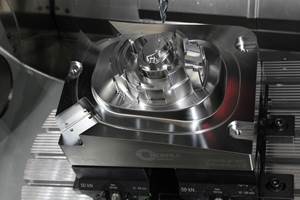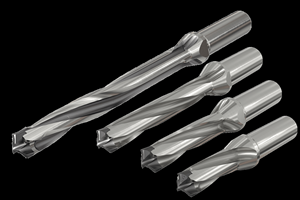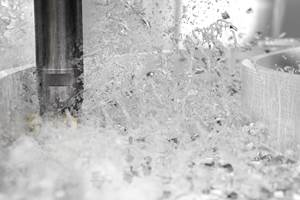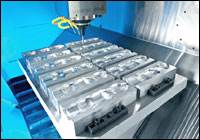Looking Sharp
Advancements in cutting tool/toolholder construction yield better stability and higher accuracy to achieve greater feedrates and increased productivity.
High-speed machining (HSM) and high productivity machining (HPM) are on the rise in moldmaking shops across the country, and cutting tool/toolholder manufacturers and suppliers are staying on the cutting edge of this market by providing more advanced, sophisticated tools so the moldmaker can use these technologies to address a top priority—the reduction of leadtimes without sacrificing quality.
Some of these top manufacturers discuss the emerging trends in this market and explain how keeping in close contact with your supplier to best apply the latest technologies in your shop will improve your productivity and tool life.
1. What major advancements to you foresee with cutting tools/toolholders this year? And how will these advancements affect the moldmaker, mold designer and the moldmaking process in general?
Duane Drape, National Sales Manager, Horn USA, Inc. (Franklin, TN): We have—and plan to—continue to increase the availability of different geometries and grades for more specialized applications. These advancements will allow the progressive moldmaker at all levels to treat his mold manufacturing as a production run rather than each individual job separately.
Konrad Forman, Product Marketing Manager, Ingersoll Cutting Tools, USA (Rockford, IL): More complex net shape dies are allowing the manufacture of unique chip forming inserts. These unique and functional inserts are coupled with carbide shanks and hardened heavy metal shanks to provide more stability in medium and long reach applications.
Tom Raun, National Product Manager Mold & Die, Iscar Metals, Inc. (Arlington, TX): Advanced technologies being used for the manufacture of cutting tools are allowing cutting tool suppliers to provide new, innovative products that are significantly better in strength and accuracy (e.g., we have used advanced pressing technologies to create carbide inserts that mount tangentially in the cutting tool. The ability to turn/rotate the insert 90 degrees significantly increases the strength of the cutting tool, allowing for greater feedrates and increased productivity). Also, the industry will continue to see advancements of carbide substrates and coatings that provide improved tool life and cost reduction.
Any advancement in technology should be in done in pursuit of eventually reducing costs. The price to implement many of the technologies involved in everyday moldmaking can be high (e.g., CAD/CAM, machine tools) and the time to achieve the break-even point for these investments can be months or even years. Investing in these technologies requires careful consideration. With that said, I feel moldmaking companies should be more aggressive in testing and implementing new cutting tool technologies. An investment in cutting tools can provide immediate results—in many cases reaching the break-even point of the investment within hours by saving time and significantly reducing manufacturing costs.
Dirk Kammermeier, Engineering Director, Kennametal Inc. (Latrobe, PA): Time-to-market is the big challenge. It is interesting to see that cost is important—but not the major driving force. Time-to-market is so important as the number of variants is increasing year by year and the response time is getting shorter and shorter. Reduced tolerances of finished parts as well as better surfaces also are major market trends. Both trends are forcing mold and die companies to look for more advanced cutting technologies. The metal cutting operation is much faster than EDM processes and smoother surfaces can be achieved.
Brian Nowicki, President, LMT-Fette, Inc. (Cleveland, OH): Cutting tool advancements that will directly affect moldmakers this year will include major improvements in coating technology. These new coatings will provide better tool life for machining harder materials and provide resistance to the heat generated with dry cutting. Also improvements with much finer insert substrates will bring crucial advantages for moldmakers, like longer tool life—and more importantly—a high degree of predictability.
Preben Hansen, National Sales Manager, Lyndex-Nikken (Mundelein, IL): Moldmakers have common objectives to increase efficiency by using HSM and differentiate themselves by producing higher quality molds in the current market climate. Toolholders have a significant effect on the balance and viability of the complete tooling system—consisting of toolholder and cutting tool—on the ability to achieve the desired results of HSM. The correct toolholder choice will have a large impact on the moldmaker—saving time and money. Another factor in trying to achieve these objectives is vibrations that are inherently induced by machining hardened materials. Vibrations can cause a number of machining problems, including tool wear, tool breakage, machine spindle wear and poor surface finish.
Matthias Koch, Marketing Manager, SCHUNK, Inc. (Morrisville, NC): With the phrase HSM becoming commonplace in our moldmaking industry and with the performance enhancements in the machine and cutting tools, the time has come to focus on the toolholder. The toolholder is the interface between two of the moldmaker’s most costly expenses—his capital investment and his perishable burden. In today’s extremely competitive marketplace, productivity holds the key to success and a precision toolholder will enhance productivity by increasing tool life with a reduction in runout, protect the machine spindle with the advent of vibration dampening and can eliminate the errors caused by over-torquing of a collet nut.
Jay Verellen, Product Manager, Seco-Carboloy, Inc. (Detroit, MI): Specific cutting edge geometry and grade advancements have widened the envelope of mold machining and dramatically reduced the time needed in manufacture, from roughing to finishing, essentially paving the way for processes like HPM, HSM and High Feed Machining (HFM). These, and other strategies, are the most common applications in modern moldmaking.
Greg Moreland, Director Product Management, Stellram (Lavergne, TN): Tool geometry and coatings are always being improved, offering incremental advancements. But, as methods to improve metal removal rates, high feed and plunge milling can provide dramatic increases in productivity. Of these two techniques, high feed milling is probably more widely employed. These tools are designed for high feedrates and shallow depths-of-cut. Most tool manufacturers are now offering versions of high feed tools. High feed tooling was first used in mold and die production, but today is gaining popularity in many other industries. In the future, more options will be available as smaller high feed inserts and high feed solid carbide tools enter the market. Plunge milling is another area where great productivity gains can be achieved. But, the acceptance of this technique has been slowed due the lack of CAM software available to take advantage of this machining method. This has begun to change, however. Recently, we have been working with major CAM providers to incorporate its plunge milling tools into their software libraries.
2. What common challenges do moldmakers face with cutting tools/toolholders today and what are some recommended solutions?
Drape, Horn USA: Moldmakers today face an increasing array of cutting tool choices; however, there are limited amounts of experienced application engineers available to help the moldmaker implement these new tools. In addition, the properly chosen and applied cutting tools are an important cog of a lights-out operation, which will allow moldmakers to compete on the international stage. The modern moldmaker needs to look at the cutting tools they are choosing on not only price, but also performance and consistency. They need to ask their cutting tool supplier how to apply the new technology and implement the technology. This requires more than a speed and feed chart, but explanations on programming paths, etc.
Forman, Ingersoll Cutting Tools, USA: Increased competition from domestic- and international-based mold and die suppliers will always be a fact of life. To survive and even flourish you must partner with shops that specialize in certain features of the process that you may not be equipped to handle. Working as partners allows you to bid on jobs that were too big in the past or had features that were too expensive to farm out to just any subcontractor. Continuous employee training (weekly or bi-weekly is preferred) must be implemented to make you faster and smarter than the other guy. Choose an employee that has a knack for a certain machining or process feature and let him tell the rest of the crew how he does it. Bring in vendors to educate on how to use each and every piece of equipment/tooling. Make sure that you get the latest training and upgrades on your software and bring it to everyone in the shop.
Raun, Iscar Metals: Challenges include finding time to keep up with and implement new cutting tools as they emerge into the market and training personnel to correctly apply cutting tools for each application (e.g., speed, feed, proper programming of cutting tool).
Of all of the challenges a moldmaker faces today, time seems to be the most critical. Finding the time to research, test and implement new technologies can seem impossible. In today’s market, moldmakers are usually faced with extremely short leadtimes. With barely enough time to complete work, where do small- to medium-sized companies find the time to keep up with the latest cutting tool technologies? The answer can, and usually does, come knocking at your door. The premier cutting tool manufacturers in the market today have technical personnel that can help companies when needed. A working relationship with your local cutting tool rep can usually get you answers when you need them. I’m not suggesting that one person has all of the answers to every application, but, two heads can be better than one and in today’s world of communications, it usually doesn’t take long for one e-mail to turn into a number of suggestions from people whose only focus is cutting tool applications.
Allowing personnel to attend industry trade shows/seminars or arranging for cutting tool companies to do periodic training sessions locally or in-house can keep programmers/operators up-to-date with the latest information and usually sparks many new ideas for improving productivity within a company.
Kammermeier, Kennametal: We have developed new tooling systems and grades to support the two major trends in the mold and die business: reduced tolerances of finished parts and better surfaces. Trochoidical-shaped cutting inserts offer increased cutting length with increased depth-of-cut and inclining radial cutting forces. A new grade, based on an ultra-fine grain material with a very thin coating, provides excellent cutting edge rigidity—which is important for sharp cutting edges.
Nowicki, LMT-Fette: One of the greatest challenges for moldmakers is getting the most out of their tooling. Although it is tempting to go with the lowest cost per tool in the current market situation, this can be very counterproductive and increase the total cost to machine. What is important is the true cost per cubic inch of metal removed. Applying the right high-performance tooling can produce a mold for less money in less time. Your tooling suppliers will have the high-performance moldmaking tools and the mold machining experience to advise and demonstrate how the higher yield tooling will reduce costs.
Hansen, Lyndex-Nikken: We have developed toolholding technology that addresses the vibration issue in the moldmaking industry. New systems eliminate noise related to high-speed rotation while reducing the air current created by the hex nuts and slots on the periphery of most toolholders. Additional benefits include longer tool life, superior surface finish and less wear on the spindle—thereby increasing its life. Looking to the future, our engineers are finalizing the development of a new toolholder that will make moldmakers more competitive—allowing them to push machines harder or enhance the capability of their lighter duty machines.
Koch, Schunk: Tool clearance has always been a nagging issue when producing a complex mold. The solutions of the past were to purchase a custom cutting tool with the reach that eliminates the toolholder clearance issue, or to purchase or to buy a small nose colleted system that gives up accuracy and tool life. Heat shrink also was developed to help with minimizing the diameter of the holder, but heat shrink is cumbersome and dangerous.
Verellen, Seco-Carboloy: Challenges include the fact that materials 48Rc and greater require specific tool properties, most notably, the need for finer carbide grain size. In general, micrograin carbide has approximately 9 to 10 percent cobalt and a grain size of around 8 microns. In contrast, when machining harder materials, the grain size needs to be reduced to closer to 5 microns and no more than 8 percent cobalt. This is necessary in order to withstand the deformation and rapid flank wear that commonly occurs when attempting to machine difficult materials. Sophisticated coatings serve to enhance wear resistance and make these grades more suitable for each operation.
Edge geometry also varies per application and material. The harder the material, the more protected the edge should be. Significant developments such as the ability to direct press and Metal Injection Mold (MIM) carbide inserts allows cutting tool manufacturers to produce complex shapes, different corner radii and exacting edge preparations.
Moreland, Stellram: The fundamental challenge faced by all mold-makers is to continually work on improving their productivity in order to remain competitive. With cutting tools, two possibilities are to improve the metal removal rate or adopt labor-saving methods with unattended machining. In a previous survey by the AMBA, it revealed that while many moldmakers had capability for unattended or lights out machining, only a small percentage was taking advantage of this opportunity. In these environments, tool performance must be consistent and predictable. Tooling manufacturers continually work on their substrates and coatings to achieve this result.
Take some time to scrutinize the cutting tools and toolholders you are currently using, ensuring you are getting the best performance and consistency for the money you are spending. By working closely with your cutting tool supplier, you can get the latest technology in your shop and learn how to properly use these instruments to achieve the greatest accuracy, longer tool life, higher productivity and the best surface finishes.
Related Content
Ten Things You Need to Know about Circle Segment Milling
Considerations for evaluating if circle segment end mills or conical barrel cutters are right for your mold machining applications.
Read More3D Printing Enables Better Coolant Delivery in Milling Operations
Just like 3D printing enabled conformal cooling channels in molds, additive manufacturing is now being used to optimize coolant delivery in cutting tools.
Read MoreModular Tooling Systems Enable Versatility in Hole-Drilling Operations
The versatility of replaceable cutting edges offers users the ability to adapt to varied operations.
Read MoreHow to Overcome Cutting Tool Vibration
Advanced indexable milling cutting tool design provides secure, predictable machining, increased metal removal rates, reduced cycle times and fast changeovers.
Read MoreRead Next
Taking Control of Finer Surface Finishes at Higher Speeds
An increased interest in five-axis machining—coupled with advances in controls and cutting tools—add up to finer surface finishes at higher speeds.
Read MoreAre You a Moldmaker Considering 3D Printing? Consider the 3D Printing Workshop at NPE2024
Presentations will cover 3D printing for mold tooling, material innovation, product development, bridge production and full-scale, high-volume additive manufacturing.
Read MoreHow to Use Strategic Planning Tools, Data to Manage the Human Side of Business
Q&A with Marion Wells, MMT EAB member and founder of Human Asset Management.
Read More
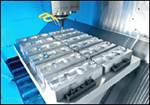


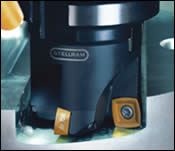

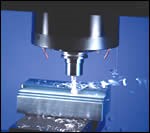




.png;maxWidth=300;quality=90)







